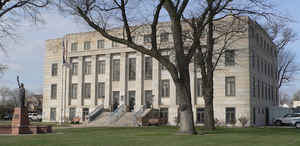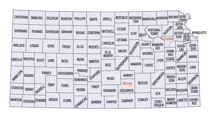Kansas Counties
Kansas has one hundred and five counties. Originally 33 counties were organized by the Territorial Legislature in 1855. The Chase County Courthouse in Cottonwood Falls, Kansas was built in 1873 and is the oldest operating courthouse in Kansas. As of January 1, 2009 Greeley County and the city of Tribune unified to form the Unified Government of Greeley County..Finney County, Kansas
Finney County Education, Geography, and History
Finney County is a county located in the state of Kansas. Based on the 2010 census, the county
population was 36,776.
Finney County was created on February 22, 1883. The
county seat and most populous city is Garden City.
The county is named in honor of David W. Finney
(1839-1916), tenth lieutenant governor of Kansas.
Finney County is included in the Garden City, KS Micropolitan Statistical Area.
Etymology - Origin of Finney County Name
The county was originally named Sequoyah, from the celebrated Cherokee Indian of that name, the inventor of the alphabet of his language, and a most remarkable man. The county named was changed in 1883 to Finney, in honor of D. W. Finney, then Lieutenant-Governor of the State.
Demographics:
County QuickFacts:
FinneyCounty History
Finney County, in the southwestern part of the state, is the third county north from the Oklahoma line and the third east from Colorado. It is bounded on the north by Scott and Lane counties; on the east by Hodgeman and Gray; on the south by Gray and Haskell, and on the west by Kearny county. This territory was settled about 1880. but was traversed at early dates by Coronado (q. v.), Pike's Expedition and the Santa Fe road.
The county was organized in 1884 and named in honor of Lieut.-Gov. David W. Finney. It then covered a much larger area than at present, the counties of Kearny, Sequoyah, Grant, Arapahoe, Kansas, Stevens, Meade and Clark, as they existed prior to 1883, were disorganized in that year to make Finney. In 1887 the area was reduced, so that it occupied less territory than it does now. In 1893 the present boundaries were formed. In Gov. Glick's proclamation organizing the county, which was made on Oct. 1, 1884, Garden City was named as the county seat
Geography: Land and Water
As reported by the Census Bureau, the county has a total area of 1,303 square miles (3,370 km2), of which 1,302 square miles (3,370 km2) is land and 0.7 square miles (1.8 km2) (0.05%) is water.
Finney county is located in west Kansas. This county is the second-largest county in Kansas by area. The county is almost level north of the Arkansas river, and rolling prairie in the south, with a span of sand dunes. Natural timber is very rare, but there are a few cottonwood trees. The government has set apart 70,000 acres, which covers nearly the whole area south of the river as a forest reserve, and has planted the most of it to artificial forest. Magnesium limestone of a fair quality and sandstone are found in the northeast. Clay for bricks exists in numerous parts of the county and potter's clay and gypsum are found in small quantities.
Points of Interest
Garden City was the longtime home of
C. J. "Buffalo" Jones who is sometimes credited with saving the buffalo from
extinction.
Garfield county was annexed into Finney county in 1893 causing Finney county's
strange shape.
Neighboring Counties
Bordering counties are as follows:
- Scott County (north)
- Lane County (north)
- Ness County (northeast)
- Hodgeman County (east)
- Haskell County (south)
- Gray County (south)
- Grant County (southwest)
- Kearny County (west)
Education
Unified School Districts
Holcomb USD 363
Garden City USD 457







